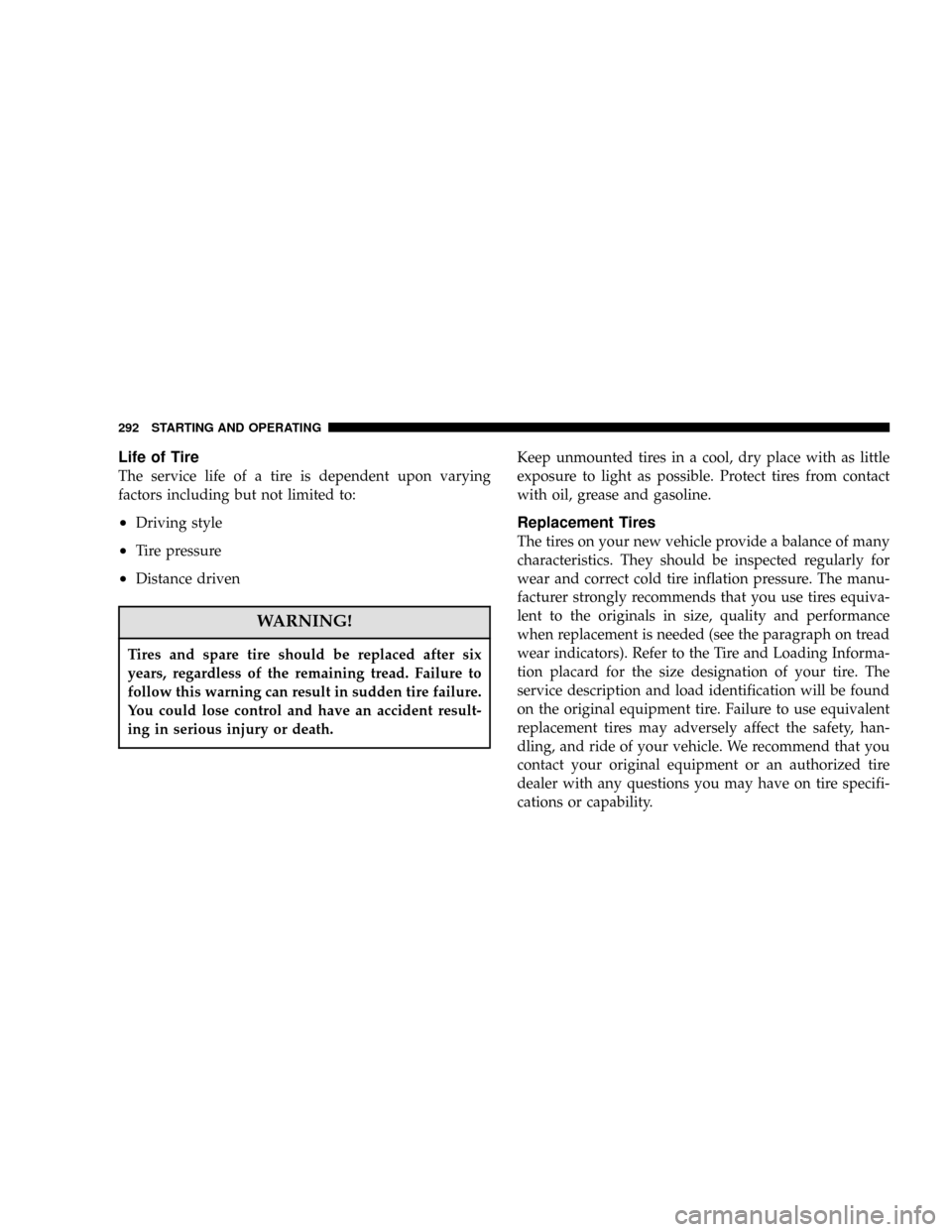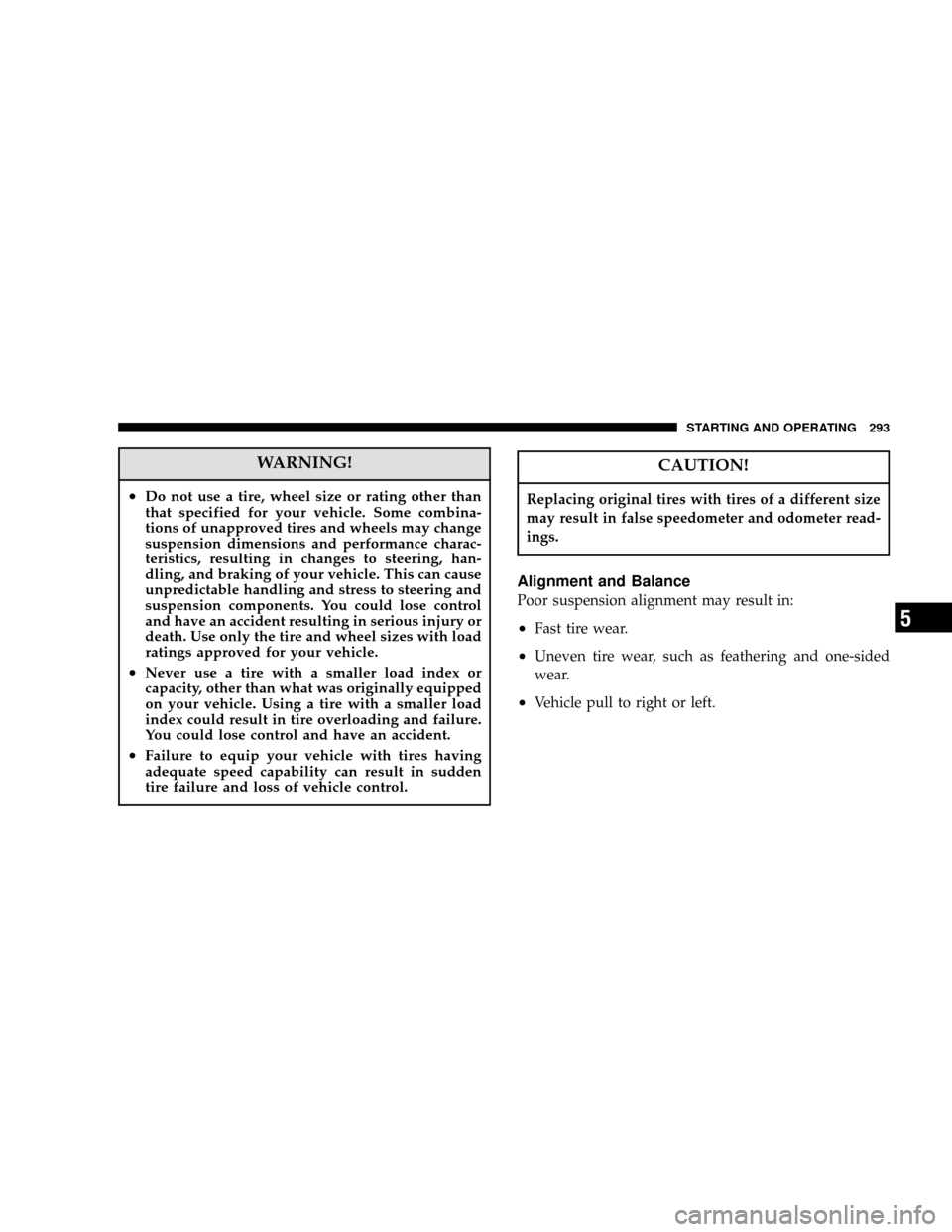2006 JEEP GRAND CHEROKEE tire size
[x] Cancel search: tire sizePage 292 of 448

Life of Tire
The service life of a tire is dependent upon varying
factors including but not limited to:
•Driving style
•Tire pressure
•Distance driven
WARNING!
Tires and spare tire should be replaced after six
years, regardless of the remaining tread. Failure to
follow this warning can result in sudden tire failure.
You could lose control and have an accident result-
ing in serious injury or death.
Keep unmounted tires in a cool, dry place with as little
exposure to light as possible. Protect tires from contact
with oil, grease and gasoline.
Replacement Tires
The tires on your new vehicle provide a balance of many
characteristics. They should be inspected regularly for
wear and correct cold tire inflation pressure. The manu-
facturer strongly recommends that you use tires equiva-
lent to the originals in size, quality and performance
when replacement is needed (see the paragraph on tread
wear indicators). Refer to the Tire and Loading Informa-
tion placard for the size designation of your tire. The
service description and load identification will be found
on the original equipment tire. Failure to use equivalent
replacement tires may adversely affect the safety, han-
dling, and ride of your vehicle. We recommend that you
contact your original equipment or an authorized tire
dealer with any questions you may have on tire specifi-
cations or capability.
292 STARTING AND OPERATING
Page 293 of 448

WARNING!
•Do not use a tire, wheel size or rating other than
that specified for your vehicle. Some combina-
tions of unapproved tires and wheels may change
suspension dimensions and performance charac-
teristics, resulting in changes to steering, han-
dling, and braking of your vehicle. This can cause
unpredictable handling and stress to steering and
suspension components. You could lose control
and have an accident resulting in serious injury or
death. Use only the tire and wheel sizes with load
ratings approved for your vehicle.
•Never use a tire with a smaller load index or
capacity, other than what was originally equipped
on your vehicle. Using a tire with a smaller load
index could result in tire overloading and failure.
You could lose control and have an accident.
•Failure to equip your vehicle with tires having
adequate speed capability can result in sudden
tire failure and loss of vehicle control.
CAUTION!
Replacing original tires with tires of a different size
may result in false speedometer and odometer read-
ings.
Alignment and Balance
Poor suspension alignment may result in:
•Fast tire wear.
•Uneven tire wear, such as feathering and one-sided
wear.
•Vehicle pull to right or left.
STARTING AND OPERATING 293
5
Page 294 of 448

Tires may also cause the vehicle to pull left or right.
Alignment will not correct this problem. See your autho-
rized dealer for proper diagnosis.
Improper alignment will not cause vehicle vibration.
Vibration may be a result of tire and wheel out-of-
balance. Proper balancing will reduce vibration and
avoid tire cupping and spotty wear.
TIRE PRESSURE MONITOR SYSTEM (TPMS)
Base System
The Tire Pressure Monitor System (TPMS) uses wireless
technology with wheel rim mounted electronic sensors to
monitor tire pressure levels. Sensors, mounted to each
wheel as part of the valve stem, transmit tire pressure
readings to the Receiver Module.
NOTE:It is particularly important, for you to check the
tire pressure in all of your tires regularly and to maintain
the proper pressure.The“Tire Pressure Monitoring Telltale Light”will
illuminate in the instrument cluster, and an au-
dible chime will be activated when one or more
tire pressures is low. The“Tire Pressure Monitoring
Telltale Light”will flash on and off for 10 to 60 seconds
when a system fault is detected. The flash cycle will
repeat every ten minutes or until the fault condition is
removed and reset.
The Tire Pressure Monitor System (TPMS) consists of the
following components:•Receiver Module
•5 Wheel Sensors (including Full Size Spare Tire)
•Tire Pressure Monitoring Telltale Light
294 STARTING AND OPERATING
Page 295 of 448

The system will consist of tire pressure monitoring
sensors attached to each wheel through the valve stem
mounting hole, a central receiver module and a“Ti re
Pressure Monitoring Telltale Light.”A sensor is located in
the spare wheel if the vehicle is equipped with a match-
ing full size spare wheel and tire assembly.
NOTE:For vehicles with optional wheel/tire sizes and
significantly different tire placard pressures, the placard
pressure value and the low-pressure threshold value is
re-programmable at your authorized dealer to accommo-
date the customer selected wheel/tire combinations rec-
ommended by DaimlerChrysler Corporation.CAUTION!
The TPMS has been optimized for the original
equipment tires and wheels. TPMS pressures have
been established for the tire size equipped on your
vehicle. Undesirable system operation or sensor
damage may result when using replacement equip-
ment that is not of the same size, type, and/or style.
After-market wheels can cause sensor damage. Do
not use tire sealant from a can, or balance beads if
your vehicle is equipped with a TPMS, as damage to
the sensors may result.
STARTING AND OPERATING 295
5
Page 297 of 448

when a system fault is detected. The flash cycle will
repeat every ten minutes or until the fault condition is
removed and reset.
The Tire Pressure Monitor System (TPMS) consists of the
following components:
•Receiver Module
•5 Wheel Sensors (including Full Size Spare Tire)
•4 Wheel Sensor Trigger Modules
•Tire Pressure Monitoring System Display Messages in
the EVIC
•Tire Pressure Monitoring Telltale LightThe system consists of tire pressure monitoring sensors
attached to each wheel through the valve stem mounting
hole, a central receiver module, Wheel Sensor Trigger
Modules mounted in three of the four wheel wells,
various Tire Pressure Monitoring System Display Mes-
sages in the EVIC, and a“Tire Pressure Monitoring
Telltale Light.”A sensor shall be installed in the spare
wheel if the vehicle is equipped with a matching full size
spare wheel and tire assembly.
NOTE:For vehicles with optional wheel/tire sizes and
significantly different tire placard pressures, the placard
pressure value and the low-pressure threshold value is
re-programmable at your authorized dealer to accommo-
date the customer selected wheel/tire combinations rec-
ommended by DaimlerChrysler Corporation.
STARTING AND OPERATING 297
5
Page 299 of 448

CAUTION!
The TPMS has been optimized for the original
equipment tires and wheels. TPMS pressures have
been established for the tire size equipped on your
vehicle. Undesirable system operation or sensor
damage may result when using replacement equip-
ment that is not of the same size, type, and/or style.
After-market wheels can cause sensor damage. Do
not use tire sealant from a can, or balance beads if
your vehicle is equipped with a TPMS, as damage to
the sensors may result.
CAUTION!
After inspecting or adjusting the tire pressure al-
ways reinstall the valve stem cap. This will prevent
moisture and dirt from entering the valve stem,
which could damage the wheel rim sensor.
NOTE:
•The TPMS can inform the driver of a low tire pressure
condition.
•The TPMS is not intended to replace normal tire care
and maintenance, nor to provide warning of a tire
failure or condition.
•The TPMS should not be used as a tire pressure gauge
while adjusting your tire pressure.
STARTING AND OPERATING 299
5
Page 300 of 448

General Information
This device complies with part 15 of the FCC rules and
RSS 210 of Industry Canada. Operation is subject to the
following conditions:
•This device may not cause harmful interference.
•This device must accept any interference received,
including interference that may cause undesired op-
eration.
The tire pressure sensors are covered under one of the
following licenses:
United States.....................KR5S120123
Canada........................2671-S120123
TIRE CHAINS
Certain models have sufficient tire-to-body clearance to
allow use of tire chains.Install chains on rear tires only.
Follow these recommendations to guard against damage
and excessive tire and chain wear:
•Do not install tire chains or traction devices on ve-
hicles with larger than P235/65R17 size tires. Tires
larger than this may not provide sufficient body
clearance with chains or other traction devices.
•Use SAE class“S”tire chains or traction devices only.
•Follow tire chain manufacturer’s instructions for
mounting chains.
•Install chains snugly and tighten after 1/2 mile (1 km)
of driving.
•Do notexceed 35 mph (56 km/h), unless otherwise
specified by the chain manufacturer.
•Drive cautiously, avoiding large bumps, potholes and
extreme driving maneuvers.
300 STARTING AND OPERATING
Page 439 of 448

Tire Identification Number (TIN)............. 282
Tire Markings.......................... 279
Tire Safety Information.................... 279
Tires ............................70,287,421
Air Pressure.......................... 288
Alignment and Balance.................. 293
Chains.............................. 300
Changing............................ 330
General Information.................... 287
High Speed.......................... 290
Inflation Pressures..................... 288
Jacking............................. 330
Life of Tires.......................... 292
Load Capacity.....................283,284
Pressure Monitor System (TPMS)........... 294
Pressure Warning Light.................. 183
Quality Grading....................... 421
Radial.............................. 290
Replacement......................... 292Rotation............................. 301
Safety............................70,279
Sizes............................... 280
Spare Tire........................... 331
Spinning............................ 290
Tread Wear Indicators................... 291
Wheel Mounting....................... 335
Tongue Weight/Trailer Weight.............. 313
Torque Converter Clutch.................. 260
Tow Hooks, Emergency................... 338
Tow/Haul Indicator Light................. 184
Towing............................308,339
Disabled Vehicle....................... 339
Guide.............................. 312
Recreational.......................... 320
Weight.............................. 312
Traction Control......................... 132
Traction Control Light.................... 182
Trailer Towing.......................... 308
INDEX 439
10